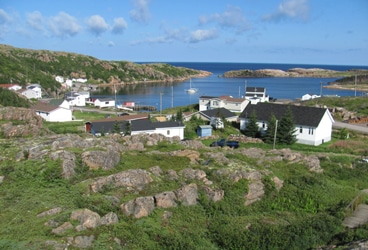
It blew near-gale or gale force four out of the five days we were at Lumsden. We hadn’t meant to stay that long—in fact we tried to leave once, when the wind was only supposed to blow 25-30. With storm try’sl and reefed stay’sl, we were making good time close-hauled against a wicked chop, which was considerable even less than a half-mile from shore. But the wind kept getting stronger, and worse, shifting gradually more and more on the bows. With a skinny passage through shoals to run, we didn’t have that greatest of sailor’s comforts: searoom. There was only one heading to make it safely though, and Ganymede simply couldn’t steer that course. It’s not often we get turned completely back (I can remember only one other time), but there was nothing else to be done. As it was, we had a job of it getting through the fairway back into Lumsden, after a two-hour return beam reach, since it was blowing a full gale by now and the little outboard can’t do much against that sort of wind.
“She’ll always blow more West around here than the forecast say,” someone told me who had watched Ganymede sailing back through the foaming crests. “Ye’re lucky there’s not much swell—sometimes she breaks right across the entrance.” I had found it more than enough swell as it was: the wind was blowing against it, which always makes for very uncomfortable, steep waves—the sort that smack the bows and send all sorts of spray flying back to soak the helmsman. Danielle had been pretty wet by the time we turned back, and I couldn’t imagine how it would have been with the seas any worse. Perhaps we would have been turned back sooner.
We got out of Lumsden at last during a rare dead calm, and it was strange to motor gently between reefs that had been vicious, ship-killing breakers just a couple days before. The predicted wind—a fair wind for once—didn’t materialize till we were just ten miles from our destination. We didn’t really mind. Once bitten, twice shy, they say, and we were feeling pretty shy of any sort of wind just then. Still, we enjoyed a couple-hours sail before arriving at Deep Cove, accessed through a rocky passage barely thirty feet wide. There was another gale on the way, so we set an extra anchor and settled in to wait it out. Deep Cove, on Fogo Island, couldn’t have been more different than Lumsden. Where that morning we had been tied up in a busy, smelly, gurry-slimed port on a coast low, grassy and windswept, we were now among rocky red hills that poked abruptly from the water, covered in patches of low scrub that proved to be mostly blueberry plants.
It was a beautiful spot, and mostly quiet, except when someone or other drove slowly down the waterfront road, turned around at the end, then drove slowly back along. It seems to be a Newfoundland thing, for everyone to get into their truck, drive aimlessly around for a spell, then do it again several hours later. We had noticed it first in Cape Broyle, when several times a day the same truck would drive onto the wharf, park for a few minutes, then drive thoughtfully away. If another of the regular drivers happened to be there, they would have a bit of a chat before moving along. Of course, here in Deep Cove they had something to look at: it’s not often a sailboat anchors in their harbor, so the stream of traffic was nearly endless. Some folks we met ashore, the only non-natives in the settlement, disclosed an extra reason we were considered of interest: Ganymede is registered in California, which proved, beyond any question, that we must be drug dealers. (Do you really think people with small children aboard would be drug runners? Our friends had asked. “That’s just to throw us all off the scent,” they answered sagely. ” Ye should be careful, talking to en.”)
While they kept a close watch on Ganymede and speculated whether our anchors would foul on the tons of lost ground tackle, engine blocks, cars, refrigerators and other junk believed to have been lost in the harbor in past years, we happily scrambled among the rocky hills, picking blueberries and enjoying the scenery. There’s a lot more in Fogo Island that we didn’t get to see, but it’ll have to wait till next time ’round. We had spent longer than our alloted time in Lumsden, and needed to make up some leeway in the calendar. Luckily our anchors came up with no difficulty, and on the third morning after arriving we threaded our way back out the narrow cleft in the rocks, past the pink rockyness of Hare Bay Head, and shaped a course for Twilingate. Again it was calm, and again we didn’t mind—around here it seems to never rain but pour, and the last thing you want when wending through rocky passages is a snorter livening up the scene.
We were looking forward to Twilingate—it was reported to be a thriving place, which always means groceries, laundry, wifi, and other comforts, which after not much of either since leaving Bonavista would be a welcome change. In certain ways it proved unique indeed; in others it was classic Newfoundland—but I’ll have to tell you all about it in a future post.
We are the Zartman family: Ben & Danielle, and our three girls, Antigone, Emily and Damaris. We created this blog to chronicle our sailing adventures on Ganymede, a home-finished 31-foot gaff-rigged cutter, which has been our home since 2009, when we sailed from San Francisco, California, to the Sea of Cortez, then down along the Central American coast. Currently in Newport, Rhode Island, we plan to sail to Canada, the U.K., and beyond this summer.








